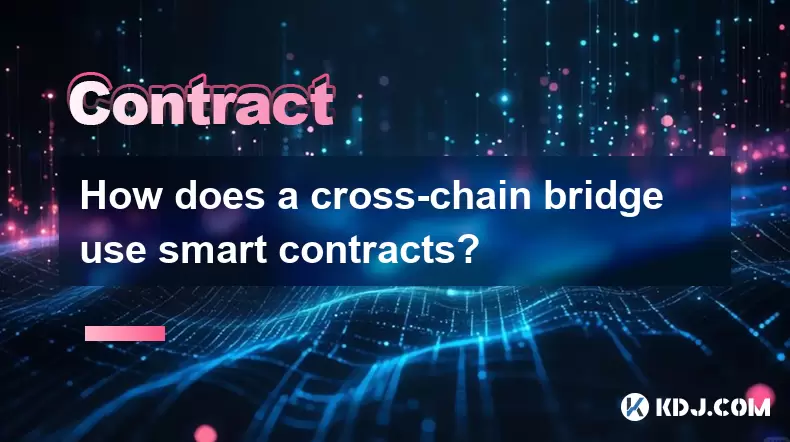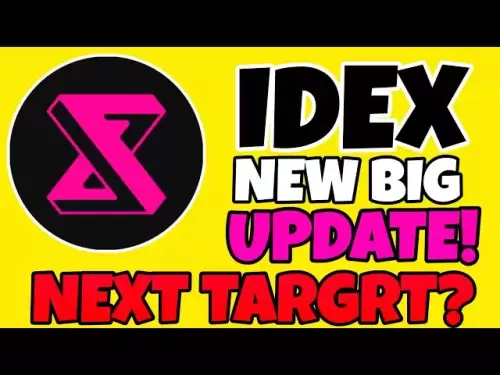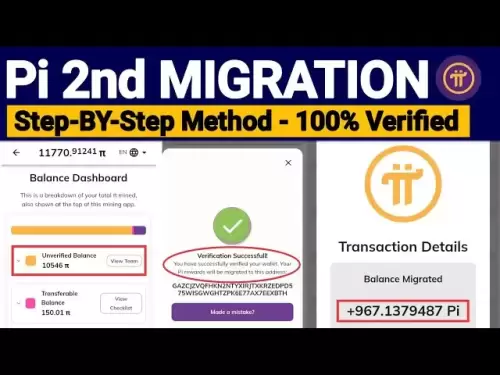-
 Bitcoin
Bitcoin $119,161.9671
1.52% -
 Ethereum
Ethereum $2,995.0722
2.34% -
 XRP
XRP $2.8555
5.32% -
 Tether USDt
Tether USDt $1.0002
0.00% -
 BNB
BNB $692.9308
1.48% -
 Solana
Solana $162.9611
1.87% -
 USDC
USDC $0.9999
0.00% -
 Dogecoin
Dogecoin $0.2014
2.84% -
 TRON
TRON $0.3032
0.90% -
 Cardano
Cardano $0.7464
6.51% -
 Hyperliquid
Hyperliquid $49.1533
5.71% -
 Stellar
Stellar $0.4773
24.77% -
 Sui
Sui $3.4979
3.93% -
 Chainlink
Chainlink $15.8552
6.01% -
 Hedera
Hedera $0.2401
23.85% -
 Bitcoin Cash
Bitcoin Cash $510.0474
0.97% -
 Avalanche
Avalanche $21.5550
4.82% -
 UNUS SED LEO
UNUS SED LEO $9.0389
-0.47% -
 Shiba Inu
Shiba Inu $0.0...01340
2.27% -
 Toncoin
Toncoin $2.9910
0.62% -
 Litecoin
Litecoin $96.4406
4.34% -
 Polkadot
Polkadot $4.0359
4.59% -
 Monero
Monero $338.4759
2.80% -
 Uniswap
Uniswap $8.6460
4.01% -
 Dai
Dai $0.9999
0.00% -
 Ethena USDe
Ethena USDe $1.0007
0.03% -
 Pepe
Pepe $0.0...01254
3.26% -
 Bitget Token
Bitget Token $4.3969
0.79% -
 Aave
Aave $312.2641
3.98% -
 Bittensor
Bittensor $397.0731
4.17%
How does a cross-chain bridge use smart contracts?
Cross-chain bridges use smart contracts to securely lock assets on one blockchain and mint equivalent tokens on another, enabling interoperability without centralized intermediaries.
Jul 13, 2025 at 11:09 pm

Understanding Cross-Chain Bridges
A cross-chain bridge is a protocol or system that allows the transfer of assets, data, or messages between two different blockchain networks. These bridges are essential for achieving interoperability in a multi-chain ecosystem. Since each blockchain operates independently with its own consensus mechanism and smart contract capabilities, cross-chain bridges act as intermediaries to facilitate communication and value transfers.
The primary function of a cross-chain bridge involves locking an asset on one chain and minting a corresponding token on another chain. This process ensures that the total supply remains consistent across chains while enabling users to interact with decentralized applications (dApps) on different blockchains.
Smart contracts play a pivotal role in this mechanism by enforcing rules, validating transactions, and ensuring trustless execution.
Role of Smart Contracts in Cross-Chain Bridges
Smart contracts are self-executing agreements with the terms of the agreement directly written into code. In the context of cross-chain bridges, they automate the verification and execution of transactions between disparate blockchains.
When a user initiates a cross-chain transfer, a smart contract on the source chain locks the native asset. Simultaneously, a corresponding smart contract on the destination chain mints a wrapped version of that asset. This wrapped token represents the original asset and can be used within the target blockchain’s ecosystem.
These contracts must be secure, auditable, and capable of handling complex logic to prevent fraud and ensure the integrity of the transferred assets.
How Locking and Minting Works
To initiate a cross-chain transaction, a user deposits their tokens into a smart contract on the source blockchain. This action triggers a series of events:
- The deposited tokens are locked inside the smart contract.
- A message is sent to the destination blockchain via a relayer or oracle.
- Upon verification, a corresponding smart contract on the destination chain mints an equivalent amount of wrapped tokens.
This process ensures that no new tokens are created without backing from the original asset. When the user decides to return the tokens to the source chain, the wrapped tokens are burned, and the original tokens are unlocked.
Each step is governed by predefined smart contract rules that eliminate the need for a centralized intermediary.
Verification Across Chains
Cross-chain bridges rely on various mechanisms to verify the state of transactions on other chains. Some bridges use oracles or light clients embedded within smart contracts to read and validate events from foreign blockchains.
For example, a smart contract on Ethereum may run a simplified payment verification (SPV) client for Bitcoin to confirm that a deposit has occurred. Alternatively, trusted nodes or validators may sign off on the validity of a transaction before it is processed on the destination chain.
These verification techniques ensure that only legitimate transfers are accepted, preventing double-spending and unauthorized minting of assets.
Security Considerations in Smart Contract Bridges
Since smart contracts control large amounts of value, they are prime targets for attackers. Any vulnerability in the contract code can lead to significant losses. Therefore, rigorous auditing, formal verification, and multi-signature validation are commonly employed to enhance security.
Some bridges implement timelocks or challenge periods where suspicious activities can be flagged before finalizing a transaction. Additionally, decentralized governance models allow stakeholders to vote on critical upgrades or decisions related to the bridge’s operation.
Security layers such as multi-party computation (MPC), threshold signatures, and zero-knowledge proofs are increasingly being integrated to mitigate risks.
Frequently Asked Questions
What happens if a smart contract in a cross-chain bridge is exploited?
If a vulnerability exists in a bridge's smart contract, attackers can exploit it to drain funds or manipulate the minting process. This has led to several high-profile hacks in the DeFi space. To mitigate this risk, developers conduct extensive audits, deploy bug bounties, and implement emergency pause functions.
Are all cross-chain bridges built using smart contracts?
Most modern cross-chain bridges utilize smart contracts to manage asset transfers and enforce rules. However, some legacy or custodial bridges rely on centralized entities to hold reserves and issue tokens, which do not fully leverage smart contract automation.
Can smart contracts communicate directly between blockchains?
Smart contracts cannot natively communicate across different blockchains. They require external infrastructure like oracles, relayers, or bridging protocols to relay information and trigger actions on another chain.
Is it possible to build a trustless cross-chain bridge using only smart contracts?
Yes, it is theoretically possible to create a trustless bridge using cryptographic proofs and on-chain light clients. However, implementing such a system requires advanced cryptography and efficient gas usage, which can be challenging on many existing blockchains.
Disclaimer:info@kdj.com
The information provided is not trading advice. kdj.com does not assume any responsibility for any investments made based on the information provided in this article. Cryptocurrencies are highly volatile and it is highly recommended that you invest with caution after thorough research!
If you believe that the content used on this website infringes your copyright, please contact us immediately (info@kdj.com) and we will delete it promptly.
- Ruvi AI: The Audited Token Primed for 100x Gem Status
- 2025-07-14 06:50:12
- Bitcoin's New Highs: Retail Interest and the Allure of Crypto Presales
- 2025-07-14 07:10:11
- Dogwifhat (WIF) Price Prediction: Bullish MACD Signals Potential Breakout
- 2025-07-14 07:10:11
- Ethereum Flips Bitcoin: Futures Volumes and the Altcoin Surge
- 2025-07-14 06:30:11
- Czech National Bank's Crypto Leap: Coinbase, Palantir, and the Future of Finance
- 2025-07-14 06:30:11
- BlockDAG's BEAT Vesting Pass: Dominating Crypto While HBAR Shows Strength
- 2025-07-14 04:30:12
Related knowledge

Psychology of trading Bitcoin contracts
Jul 13,2025 at 02:50am
Understanding the Emotional Rollercoaster of Bitcoin Futures TradingBitcoin contract trading, especially in the form of futures, introduces a high lev...

Best time of day to trade Bitcoin contracts?
Jul 13,2025 at 05:29am
Understanding Bitcoin Contracts and Their VolatilityBitcoin contracts, particularly futures contracts, are derivative instruments that allow traders t...

How to use Fibonacci levels in Bitcoin contract trading?
Jul 13,2025 at 08:07am
Understanding Fibonacci Levels in TradingFibonacci levels are a technical analysis tool used by traders to identify potential support and resistance z...

Understanding the Bitcoin futures term structure
Jul 13,2025 at 08:28am
What is Bitcoin Futures Term Structure?The Bitcoin futures term structure refers to the relationship between the prices of Bitcoin futures contracts w...

What are the trading hours for Bitcoin futures?
Jul 13,2025 at 12:14pm
Understanding Bitcoin Futures Trading HoursBitcoin futures are derivative contracts that allow traders to speculate on the future price of Bitcoin wit...

How to withdraw profits from a futures account?
Jul 13,2025 at 07:07am
Understanding Futures Accounts and Withdrawal MechanicsIn the cryptocurrency space, a futures account is used to trade contracts that derive their val...

Psychology of trading Bitcoin contracts
Jul 13,2025 at 02:50am
Understanding the Emotional Rollercoaster of Bitcoin Futures TradingBitcoin contract trading, especially in the form of futures, introduces a high lev...

Best time of day to trade Bitcoin contracts?
Jul 13,2025 at 05:29am
Understanding Bitcoin Contracts and Their VolatilityBitcoin contracts, particularly futures contracts, are derivative instruments that allow traders t...

How to use Fibonacci levels in Bitcoin contract trading?
Jul 13,2025 at 08:07am
Understanding Fibonacci Levels in TradingFibonacci levels are a technical analysis tool used by traders to identify potential support and resistance z...

Understanding the Bitcoin futures term structure
Jul 13,2025 at 08:28am
What is Bitcoin Futures Term Structure?The Bitcoin futures term structure refers to the relationship between the prices of Bitcoin futures contracts w...

What are the trading hours for Bitcoin futures?
Jul 13,2025 at 12:14pm
Understanding Bitcoin Futures Trading HoursBitcoin futures are derivative contracts that allow traders to speculate on the future price of Bitcoin wit...

How to withdraw profits from a futures account?
Jul 13,2025 at 07:07am
Understanding Futures Accounts and Withdrawal MechanicsIn the cryptocurrency space, a futures account is used to trade contracts that derive their val...
See all articles
























































































